Knowledge Management Report: Technologies, Framework and Processes
VerifiedAdded on 2020/03/16
|23
|5107
|31
Report
AI Summary
This report provides a comprehensive overview of knowledge management, exploring three key technologies: case-based reasoning systems, group decision support systems, and artificial neural networks. It delves into the functionalities, advantages, and disadvantages of each technology, offering insights into their practical applications within organizations. The report also introduces a product, "Knowledge Framework," designed to simplify decision-making processes by organizing knowledge into manageable units. It further discusses the product's features, its support for the SECI model, and potential areas for improvement. In addition to the technological aspects, the report touches upon the broader context of knowledge management, including KM processes, leadership, culture, technology, and measurement. The report is well-structured, providing detailed analysis and insights into the effective management and utilization of knowledge within an organizational setting.
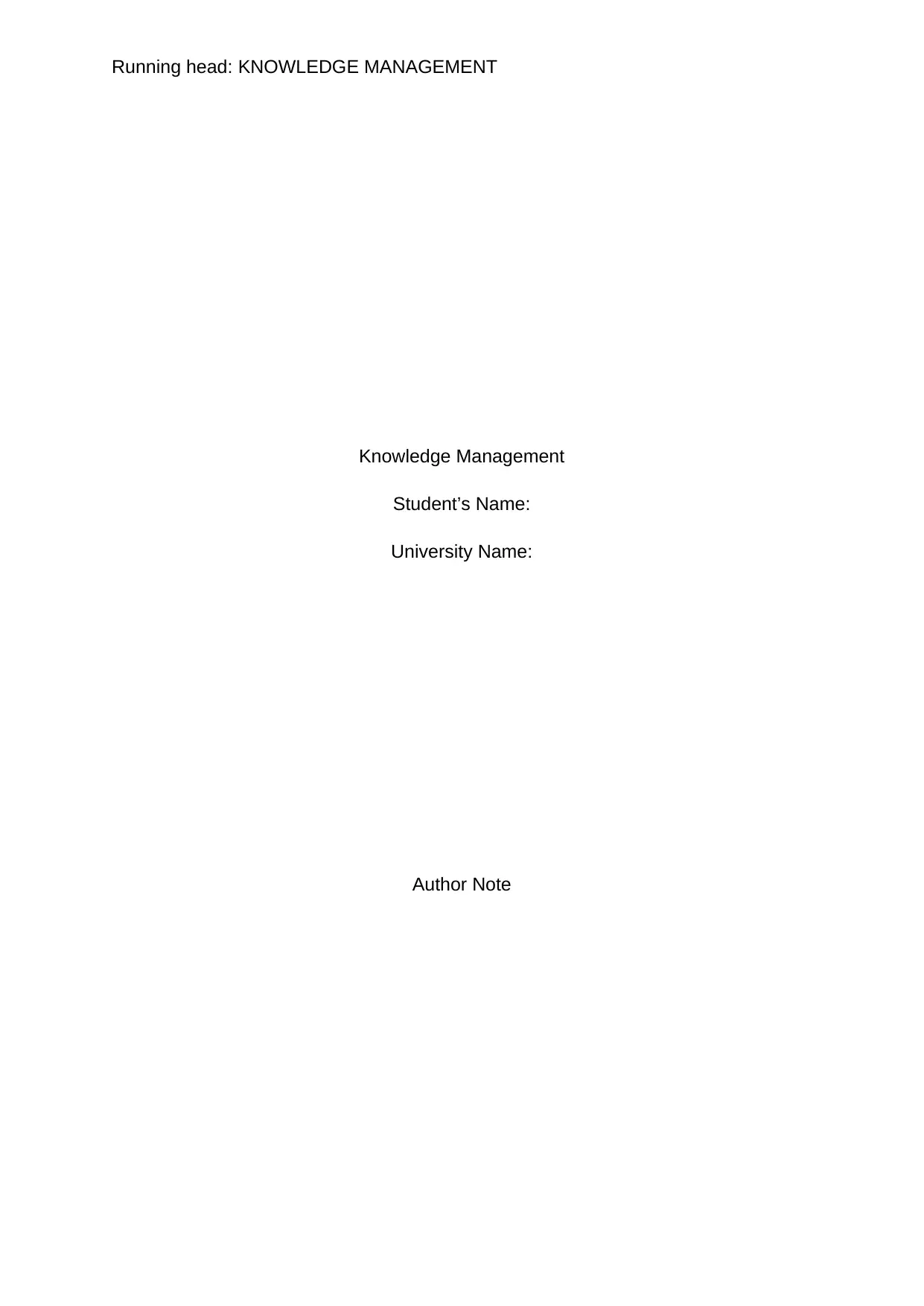
Running head: KNOWLEDGE MANAGEMENT
Knowledge Management
Student’s Name:
University Name:
Author Note
Knowledge Management
Student’s Name:
University Name:
Author Note
Paraphrase This Document
Need a fresh take? Get an instant paraphrase of this document with our AI Paraphraser
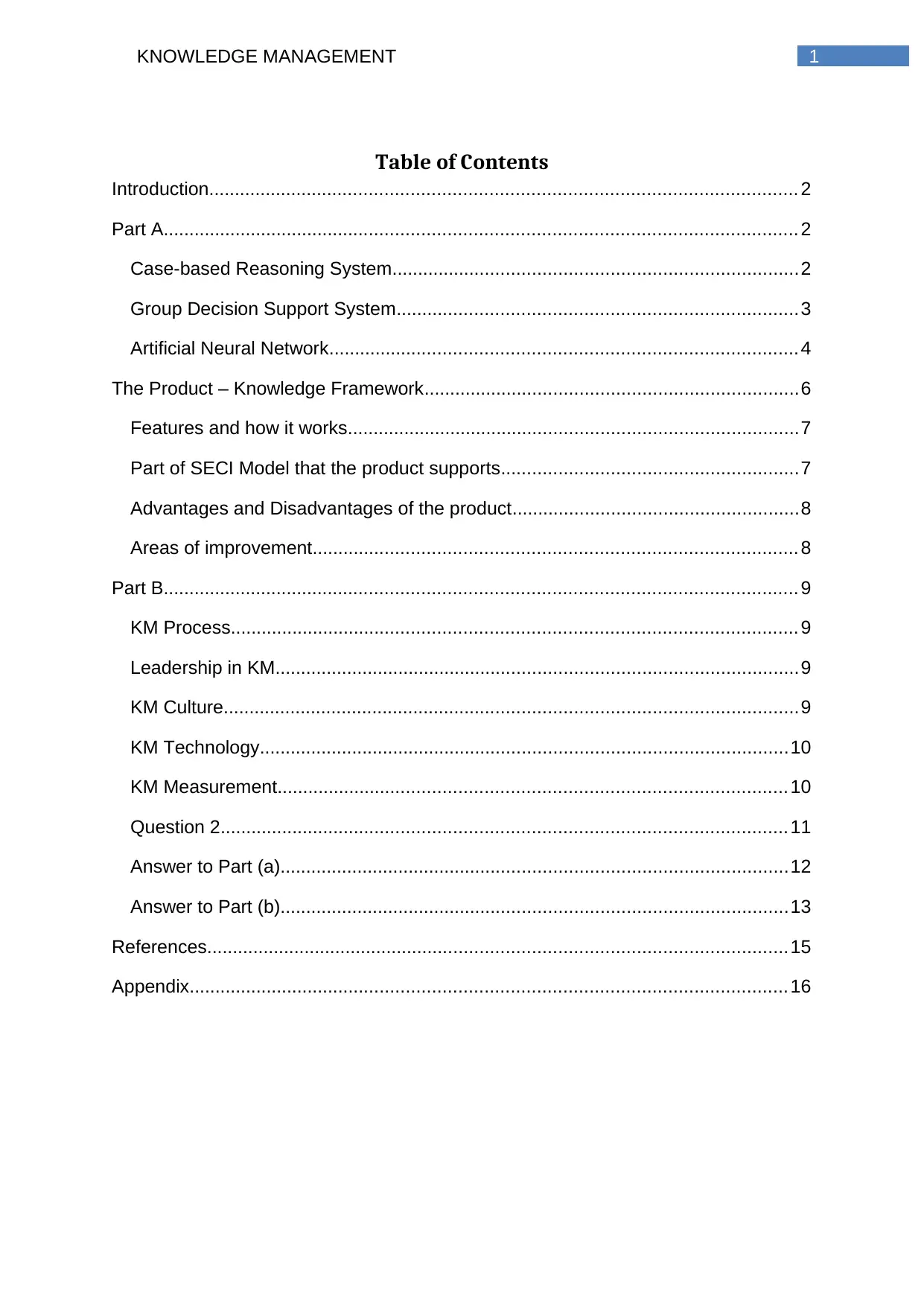
1KNOWLEDGE MANAGEMENT
Table of Contents
Introduction................................................................................................................. 2
Part A.......................................................................................................................... 2
Case-based Reasoning System..............................................................................2
Group Decision Support System.............................................................................3
Artificial Neural Network..........................................................................................4
The Product – Knowledge Framework........................................................................6
Features and how it works.......................................................................................7
Part of SECI Model that the product supports.........................................................7
Advantages and Disadvantages of the product.......................................................8
Areas of improvement............................................................................................. 8
Part B.......................................................................................................................... 9
KM Process............................................................................................................. 9
Leadership in KM.....................................................................................................9
KM Culture...............................................................................................................9
KM Technology......................................................................................................10
KM Measurement.................................................................................................. 10
Question 2.............................................................................................................11
Answer to Part (a)..................................................................................................12
Answer to Part (b)..................................................................................................13
References................................................................................................................15
Appendix................................................................................................................... 16
Table of Contents
Introduction................................................................................................................. 2
Part A.......................................................................................................................... 2
Case-based Reasoning System..............................................................................2
Group Decision Support System.............................................................................3
Artificial Neural Network..........................................................................................4
The Product – Knowledge Framework........................................................................6
Features and how it works.......................................................................................7
Part of SECI Model that the product supports.........................................................7
Advantages and Disadvantages of the product.......................................................8
Areas of improvement............................................................................................. 8
Part B.......................................................................................................................... 9
KM Process............................................................................................................. 9
Leadership in KM.....................................................................................................9
KM Culture...............................................................................................................9
KM Technology......................................................................................................10
KM Measurement.................................................................................................. 10
Question 2.............................................................................................................11
Answer to Part (a)..................................................................................................12
Answer to Part (b)..................................................................................................13
References................................................................................................................15
Appendix................................................................................................................... 16
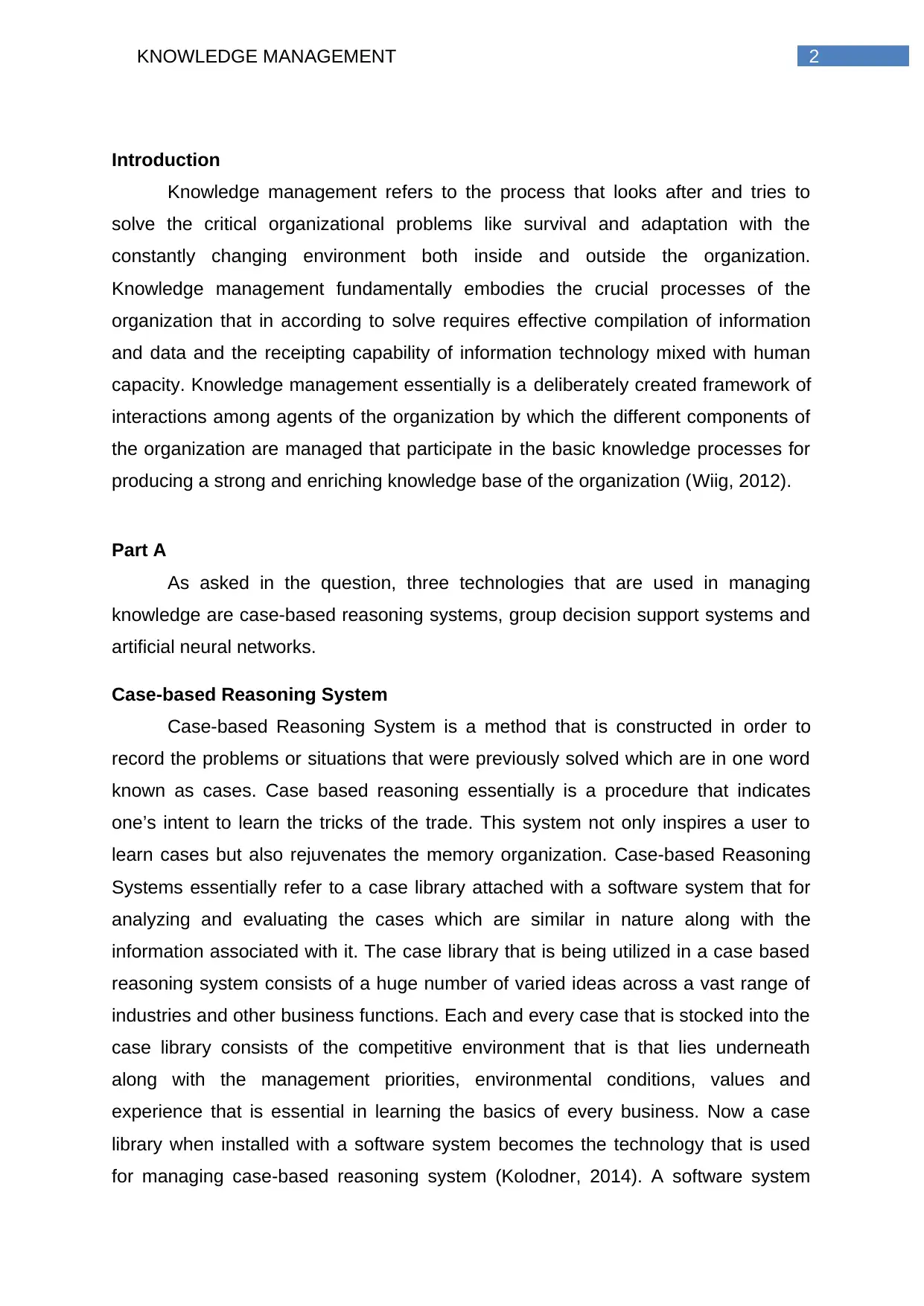
2KNOWLEDGE MANAGEMENT
Introduction
Knowledge management refers to the process that looks after and tries to
solve the critical organizational problems like survival and adaptation with the
constantly changing environment both inside and outside the organization.
Knowledge management fundamentally embodies the crucial processes of the
organization that in according to solve requires effective compilation of information
and data and the receipting capability of information technology mixed with human
capacity. Knowledge management essentially is a deliberately created framework of
interactions among agents of the organization by which the different components of
the organization are managed that participate in the basic knowledge processes for
producing a strong and enriching knowledge base of the organization (Wiig, 2012).
Part A
As asked in the question, three technologies that are used in managing
knowledge are case-based reasoning systems, group decision support systems and
artificial neural networks.
Case-based Reasoning System
Case-based Reasoning System is a method that is constructed in order to
record the problems or situations that were previously solved which are in one word
known as cases. Case based reasoning essentially is a procedure that indicates
one’s intent to learn the tricks of the trade. This system not only inspires a user to
learn cases but also rejuvenates the memory organization. Case-based Reasoning
Systems essentially refer to a case library attached with a software system that for
analyzing and evaluating the cases which are similar in nature along with the
information associated with it. The case library that is being utilized in a case based
reasoning system consists of a huge number of varied ideas across a vast range of
industries and other business functions. Each and every case that is stocked into the
case library consists of the competitive environment that is that lies underneath
along with the management priorities, environmental conditions, values and
experience that is essential in learning the basics of every business. Now a case
library when installed with a software system becomes the technology that is used
for managing case-based reasoning system (Kolodner, 2014). A software system
Introduction
Knowledge management refers to the process that looks after and tries to
solve the critical organizational problems like survival and adaptation with the
constantly changing environment both inside and outside the organization.
Knowledge management fundamentally embodies the crucial processes of the
organization that in according to solve requires effective compilation of information
and data and the receipting capability of information technology mixed with human
capacity. Knowledge management essentially is a deliberately created framework of
interactions among agents of the organization by which the different components of
the organization are managed that participate in the basic knowledge processes for
producing a strong and enriching knowledge base of the organization (Wiig, 2012).
Part A
As asked in the question, three technologies that are used in managing
knowledge are case-based reasoning systems, group decision support systems and
artificial neural networks.
Case-based Reasoning System
Case-based Reasoning System is a method that is constructed in order to
record the problems or situations that were previously solved which are in one word
known as cases. Case based reasoning essentially is a procedure that indicates
one’s intent to learn the tricks of the trade. This system not only inspires a user to
learn cases but also rejuvenates the memory organization. Case-based Reasoning
Systems essentially refer to a case library attached with a software system that for
analyzing and evaluating the cases which are similar in nature along with the
information associated with it. The case library that is being utilized in a case based
reasoning system consists of a huge number of varied ideas across a vast range of
industries and other business functions. Each and every case that is stocked into the
case library consists of the competitive environment that is that lies underneath
along with the management priorities, environmental conditions, values and
experience that is essential in learning the basics of every business. Now a case
library when installed with a software system becomes the technology that is used
for managing case-based reasoning system (Kolodner, 2014). A software system
⊘ This is a preview!⊘
Do you want full access?
Subscribe today to unlock all pages.

Trusted by 1+ million students worldwide
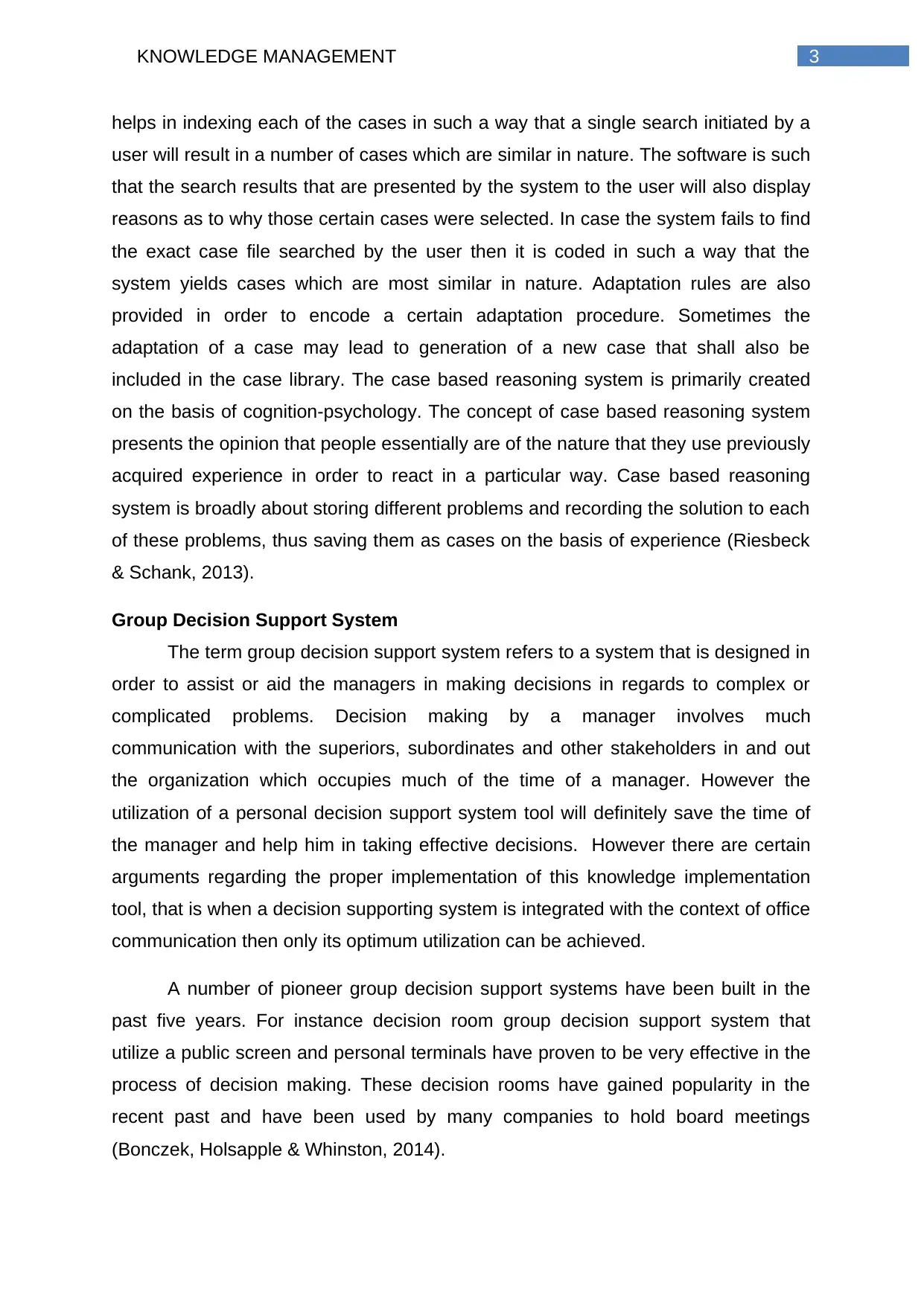
3KNOWLEDGE MANAGEMENT
helps in indexing each of the cases in such a way that a single search initiated by a
user will result in a number of cases which are similar in nature. The software is such
that the search results that are presented by the system to the user will also display
reasons as to why those certain cases were selected. In case the system fails to find
the exact case file searched by the user then it is coded in such a way that the
system yields cases which are most similar in nature. Adaptation rules are also
provided in order to encode a certain adaptation procedure. Sometimes the
adaptation of a case may lead to generation of a new case that shall also be
included in the case library. The case based reasoning system is primarily created
on the basis of cognition-psychology. The concept of case based reasoning system
presents the opinion that people essentially are of the nature that they use previously
acquired experience in order to react in a particular way. Case based reasoning
system is broadly about storing different problems and recording the solution to each
of these problems, thus saving them as cases on the basis of experience (Riesbeck
& Schank, 2013).
Group Decision Support System
The term group decision support system refers to a system that is designed in
order to assist or aid the managers in making decisions in regards to complex or
complicated problems. Decision making by a manager involves much
communication with the superiors, subordinates and other stakeholders in and out
the organization which occupies much of the time of a manager. However the
utilization of a personal decision support system tool will definitely save the time of
the manager and help him in taking effective decisions. However there are certain
arguments regarding the proper implementation of this knowledge implementation
tool, that is when a decision supporting system is integrated with the context of office
communication then only its optimum utilization can be achieved.
A number of pioneer group decision support systems have been built in the
past five years. For instance decision room group decision support system that
utilize a public screen and personal terminals have proven to be very effective in the
process of decision making. These decision rooms have gained popularity in the
recent past and have been used by many companies to hold board meetings
(Bonczek, Holsapple & Whinston, 2014).
helps in indexing each of the cases in such a way that a single search initiated by a
user will result in a number of cases which are similar in nature. The software is such
that the search results that are presented by the system to the user will also display
reasons as to why those certain cases were selected. In case the system fails to find
the exact case file searched by the user then it is coded in such a way that the
system yields cases which are most similar in nature. Adaptation rules are also
provided in order to encode a certain adaptation procedure. Sometimes the
adaptation of a case may lead to generation of a new case that shall also be
included in the case library. The case based reasoning system is primarily created
on the basis of cognition-psychology. The concept of case based reasoning system
presents the opinion that people essentially are of the nature that they use previously
acquired experience in order to react in a particular way. Case based reasoning
system is broadly about storing different problems and recording the solution to each
of these problems, thus saving them as cases on the basis of experience (Riesbeck
& Schank, 2013).
Group Decision Support System
The term group decision support system refers to a system that is designed in
order to assist or aid the managers in making decisions in regards to complex or
complicated problems. Decision making by a manager involves much
communication with the superiors, subordinates and other stakeholders in and out
the organization which occupies much of the time of a manager. However the
utilization of a personal decision support system tool will definitely save the time of
the manager and help him in taking effective decisions. However there are certain
arguments regarding the proper implementation of this knowledge implementation
tool, that is when a decision supporting system is integrated with the context of office
communication then only its optimum utilization can be achieved.
A number of pioneer group decision support systems have been built in the
past five years. For instance decision room group decision support system that
utilize a public screen and personal terminals have proven to be very effective in the
process of decision making. These decision rooms have gained popularity in the
recent past and have been used by many companies to hold board meetings
(Bonczek, Holsapple & Whinston, 2014).
Paraphrase This Document
Need a fresh take? Get an instant paraphrase of this document with our AI Paraphraser
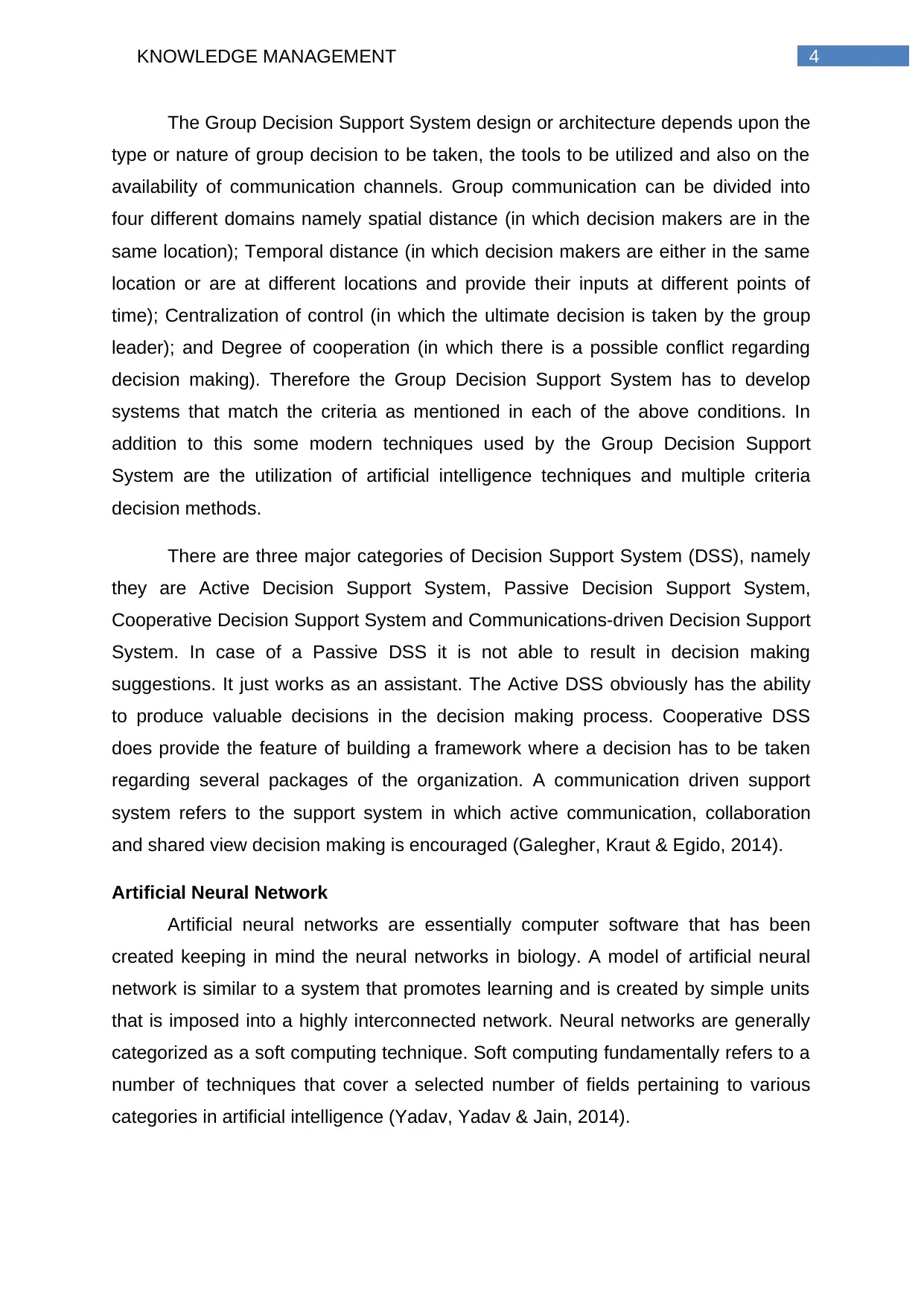
4KNOWLEDGE MANAGEMENT
The Group Decision Support System design or architecture depends upon the
type or nature of group decision to be taken, the tools to be utilized and also on the
availability of communication channels. Group communication can be divided into
four different domains namely spatial distance (in which decision makers are in the
same location); Temporal distance (in which decision makers are either in the same
location or are at different locations and provide their inputs at different points of
time); Centralization of control (in which the ultimate decision is taken by the group
leader); and Degree of cooperation (in which there is a possible conflict regarding
decision making). Therefore the Group Decision Support System has to develop
systems that match the criteria as mentioned in each of the above conditions. In
addition to this some modern techniques used by the Group Decision Support
System are the utilization of artificial intelligence techniques and multiple criteria
decision methods.
There are three major categories of Decision Support System (DSS), namely
they are Active Decision Support System, Passive Decision Support System,
Cooperative Decision Support System and Communications-driven Decision Support
System. In case of a Passive DSS it is not able to result in decision making
suggestions. It just works as an assistant. The Active DSS obviously has the ability
to produce valuable decisions in the decision making process. Cooperative DSS
does provide the feature of building a framework where a decision has to be taken
regarding several packages of the organization. A communication driven support
system refers to the support system in which active communication, collaboration
and shared view decision making is encouraged (Galegher, Kraut & Egido, 2014).
Artificial Neural Network
Artificial neural networks are essentially computer software that has been
created keeping in mind the neural networks in biology. A model of artificial neural
network is similar to a system that promotes learning and is created by simple units
that is imposed into a highly interconnected network. Neural networks are generally
categorized as a soft computing technique. Soft computing fundamentally refers to a
number of techniques that cover a selected number of fields pertaining to various
categories in artificial intelligence (Yadav, Yadav & Jain, 2014).
The Group Decision Support System design or architecture depends upon the
type or nature of group decision to be taken, the tools to be utilized and also on the
availability of communication channels. Group communication can be divided into
four different domains namely spatial distance (in which decision makers are in the
same location); Temporal distance (in which decision makers are either in the same
location or are at different locations and provide their inputs at different points of
time); Centralization of control (in which the ultimate decision is taken by the group
leader); and Degree of cooperation (in which there is a possible conflict regarding
decision making). Therefore the Group Decision Support System has to develop
systems that match the criteria as mentioned in each of the above conditions. In
addition to this some modern techniques used by the Group Decision Support
System are the utilization of artificial intelligence techniques and multiple criteria
decision methods.
There are three major categories of Decision Support System (DSS), namely
they are Active Decision Support System, Passive Decision Support System,
Cooperative Decision Support System and Communications-driven Decision Support
System. In case of a Passive DSS it is not able to result in decision making
suggestions. It just works as an assistant. The Active DSS obviously has the ability
to produce valuable decisions in the decision making process. Cooperative DSS
does provide the feature of building a framework where a decision has to be taken
regarding several packages of the organization. A communication driven support
system refers to the support system in which active communication, collaboration
and shared view decision making is encouraged (Galegher, Kraut & Egido, 2014).
Artificial Neural Network
Artificial neural networks are essentially computer software that has been
created keeping in mind the neural networks in biology. A model of artificial neural
network is similar to a system that promotes learning and is created by simple units
that is imposed into a highly interconnected network. Neural networks are generally
categorized as a soft computing technique. Soft computing fundamentally refers to a
number of techniques that cover a selected number of fields pertaining to various
categories in artificial intelligence (Yadav, Yadav & Jain, 2014).
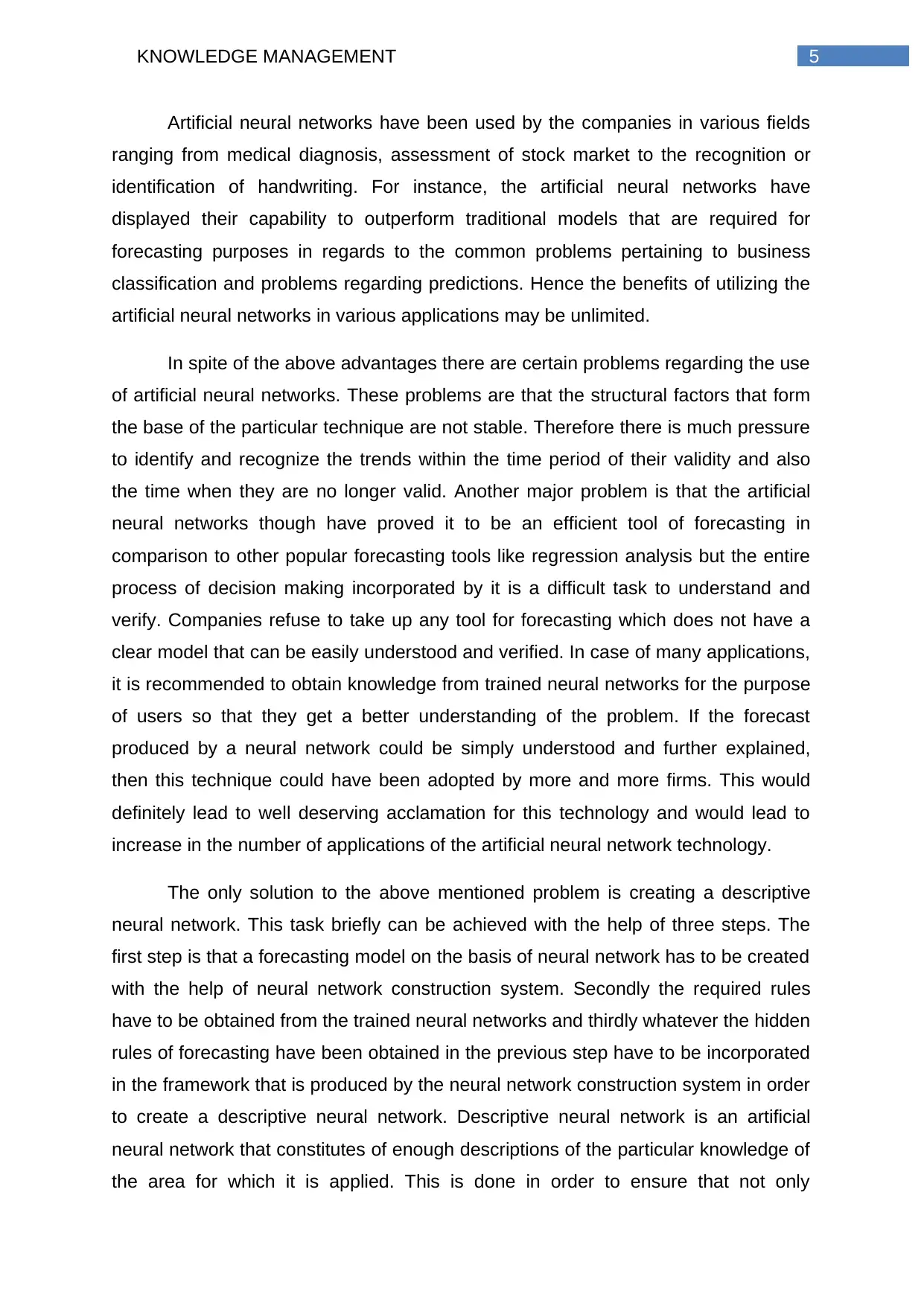
5KNOWLEDGE MANAGEMENT
Artificial neural networks have been used by the companies in various fields
ranging from medical diagnosis, assessment of stock market to the recognition or
identification of handwriting. For instance, the artificial neural networks have
displayed their capability to outperform traditional models that are required for
forecasting purposes in regards to the common problems pertaining to business
classification and problems regarding predictions. Hence the benefits of utilizing the
artificial neural networks in various applications may be unlimited.
In spite of the above advantages there are certain problems regarding the use
of artificial neural networks. These problems are that the structural factors that form
the base of the particular technique are not stable. Therefore there is much pressure
to identify and recognize the trends within the time period of their validity and also
the time when they are no longer valid. Another major problem is that the artificial
neural networks though have proved it to be an efficient tool of forecasting in
comparison to other popular forecasting tools like regression analysis but the entire
process of decision making incorporated by it is a difficult task to understand and
verify. Companies refuse to take up any tool for forecasting which does not have a
clear model that can be easily understood and verified. In case of many applications,
it is recommended to obtain knowledge from trained neural networks for the purpose
of users so that they get a better understanding of the problem. If the forecast
produced by a neural network could be simply understood and further explained,
then this technique could have been adopted by more and more firms. This would
definitely lead to well deserving acclamation for this technology and would lead to
increase in the number of applications of the artificial neural network technology.
The only solution to the above mentioned problem is creating a descriptive
neural network. This task briefly can be achieved with the help of three steps. The
first step is that a forecasting model on the basis of neural network has to be created
with the help of neural network construction system. Secondly the required rules
have to be obtained from the trained neural networks and thirdly whatever the hidden
rules of forecasting have been obtained in the previous step have to be incorporated
in the framework that is produced by the neural network construction system in order
to create a descriptive neural network. Descriptive neural network is an artificial
neural network that constitutes of enough descriptions of the particular knowledge of
the area for which it is applied. This is done in order to ensure that not only
Artificial neural networks have been used by the companies in various fields
ranging from medical diagnosis, assessment of stock market to the recognition or
identification of handwriting. For instance, the artificial neural networks have
displayed their capability to outperform traditional models that are required for
forecasting purposes in regards to the common problems pertaining to business
classification and problems regarding predictions. Hence the benefits of utilizing the
artificial neural networks in various applications may be unlimited.
In spite of the above advantages there are certain problems regarding the use
of artificial neural networks. These problems are that the structural factors that form
the base of the particular technique are not stable. Therefore there is much pressure
to identify and recognize the trends within the time period of their validity and also
the time when they are no longer valid. Another major problem is that the artificial
neural networks though have proved it to be an efficient tool of forecasting in
comparison to other popular forecasting tools like regression analysis but the entire
process of decision making incorporated by it is a difficult task to understand and
verify. Companies refuse to take up any tool for forecasting which does not have a
clear model that can be easily understood and verified. In case of many applications,
it is recommended to obtain knowledge from trained neural networks for the purpose
of users so that they get a better understanding of the problem. If the forecast
produced by a neural network could be simply understood and further explained,
then this technique could have been adopted by more and more firms. This would
definitely lead to well deserving acclamation for this technology and would lead to
increase in the number of applications of the artificial neural network technology.
The only solution to the above mentioned problem is creating a descriptive
neural network. This task briefly can be achieved with the help of three steps. The
first step is that a forecasting model on the basis of neural network has to be created
with the help of neural network construction system. Secondly the required rules
have to be obtained from the trained neural networks and thirdly whatever the hidden
rules of forecasting have been obtained in the previous step have to be incorporated
in the framework that is produced by the neural network construction system in order
to create a descriptive neural network. Descriptive neural network is an artificial
neural network that constitutes of enough descriptions of the particular knowledge of
the area for which it is applied. This is done in order to ensure that not only
⊘ This is a preview!⊘
Do you want full access?
Subscribe today to unlock all pages.

Trusted by 1+ million students worldwide
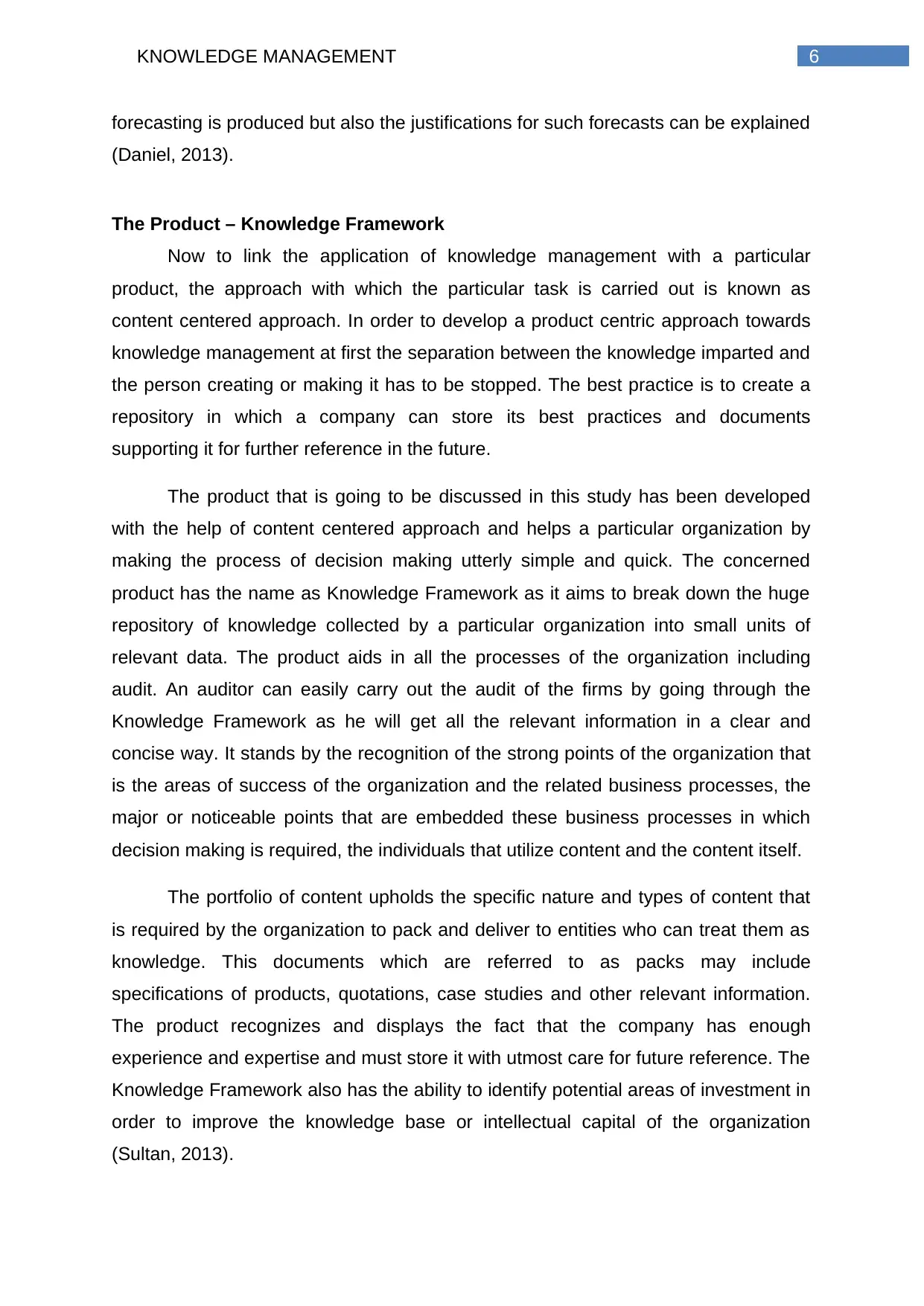
6KNOWLEDGE MANAGEMENT
forecasting is produced but also the justifications for such forecasts can be explained
(Daniel, 2013).
The Product – Knowledge Framework
Now to link the application of knowledge management with a particular
product, the approach with which the particular task is carried out is known as
content centered approach. In order to develop a product centric approach towards
knowledge management at first the separation between the knowledge imparted and
the person creating or making it has to be stopped. The best practice is to create a
repository in which a company can store its best practices and documents
supporting it for further reference in the future.
The product that is going to be discussed in this study has been developed
with the help of content centered approach and helps a particular organization by
making the process of decision making utterly simple and quick. The concerned
product has the name as Knowledge Framework as it aims to break down the huge
repository of knowledge collected by a particular organization into small units of
relevant data. The product aids in all the processes of the organization including
audit. An auditor can easily carry out the audit of the firms by going through the
Knowledge Framework as he will get all the relevant information in a clear and
concise way. It stands by the recognition of the strong points of the organization that
is the areas of success of the organization and the related business processes, the
major or noticeable points that are embedded these business processes in which
decision making is required, the individuals that utilize content and the content itself.
The portfolio of content upholds the specific nature and types of content that
is required by the organization to pack and deliver to entities who can treat them as
knowledge. This documents which are referred to as packs may include
specifications of products, quotations, case studies and other relevant information.
The product recognizes and displays the fact that the company has enough
experience and expertise and must store it with utmost care for future reference. The
Knowledge Framework also has the ability to identify potential areas of investment in
order to improve the knowledge base or intellectual capital of the organization
(Sultan, 2013).
forecasting is produced but also the justifications for such forecasts can be explained
(Daniel, 2013).
The Product – Knowledge Framework
Now to link the application of knowledge management with a particular
product, the approach with which the particular task is carried out is known as
content centered approach. In order to develop a product centric approach towards
knowledge management at first the separation between the knowledge imparted and
the person creating or making it has to be stopped. The best practice is to create a
repository in which a company can store its best practices and documents
supporting it for further reference in the future.
The product that is going to be discussed in this study has been developed
with the help of content centered approach and helps a particular organization by
making the process of decision making utterly simple and quick. The concerned
product has the name as Knowledge Framework as it aims to break down the huge
repository of knowledge collected by a particular organization into small units of
relevant data. The product aids in all the processes of the organization including
audit. An auditor can easily carry out the audit of the firms by going through the
Knowledge Framework as he will get all the relevant information in a clear and
concise way. It stands by the recognition of the strong points of the organization that
is the areas of success of the organization and the related business processes, the
major or noticeable points that are embedded these business processes in which
decision making is required, the individuals that utilize content and the content itself.
The portfolio of content upholds the specific nature and types of content that
is required by the organization to pack and deliver to entities who can treat them as
knowledge. This documents which are referred to as packs may include
specifications of products, quotations, case studies and other relevant information.
The product recognizes and displays the fact that the company has enough
experience and expertise and must store it with utmost care for future reference. The
Knowledge Framework also has the ability to identify potential areas of investment in
order to improve the knowledge base or intellectual capital of the organization
(Sultan, 2013).
Paraphrase This Document
Need a fresh take? Get an instant paraphrase of this document with our AI Paraphraser
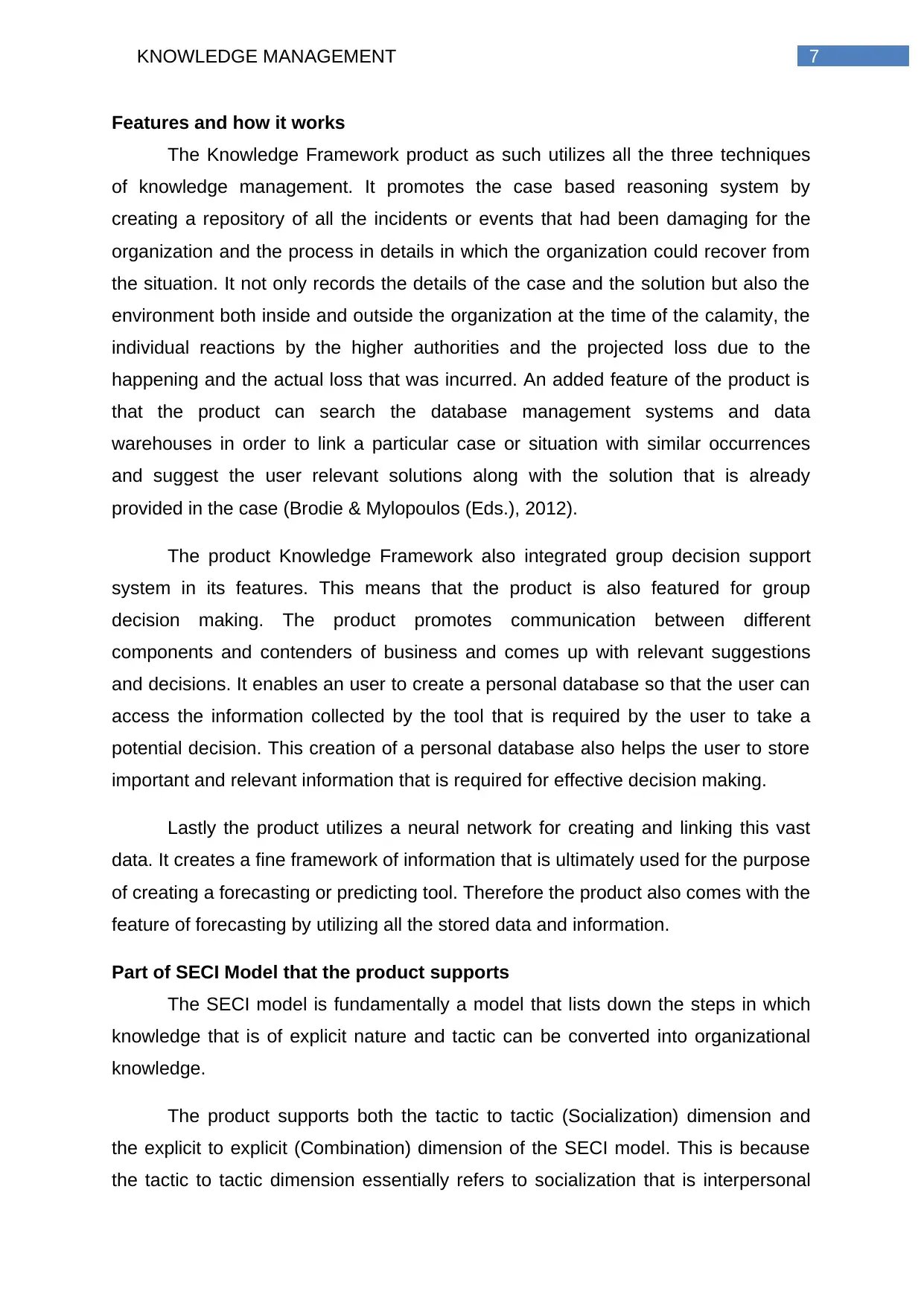
7KNOWLEDGE MANAGEMENT
Features and how it works
The Knowledge Framework product as such utilizes all the three techniques
of knowledge management. It promotes the case based reasoning system by
creating a repository of all the incidents or events that had been damaging for the
organization and the process in details in which the organization could recover from
the situation. It not only records the details of the case and the solution but also the
environment both inside and outside the organization at the time of the calamity, the
individual reactions by the higher authorities and the projected loss due to the
happening and the actual loss that was incurred. An added feature of the product is
that the product can search the database management systems and data
warehouses in order to link a particular case or situation with similar occurrences
and suggest the user relevant solutions along with the solution that is already
provided in the case (Brodie & Mylopoulos (Eds.), 2012).
The product Knowledge Framework also integrated group decision support
system in its features. This means that the product is also featured for group
decision making. The product promotes communication between different
components and contenders of business and comes up with relevant suggestions
and decisions. It enables an user to create a personal database so that the user can
access the information collected by the tool that is required by the user to take a
potential decision. This creation of a personal database also helps the user to store
important and relevant information that is required for effective decision making.
Lastly the product utilizes a neural network for creating and linking this vast
data. It creates a fine framework of information that is ultimately used for the purpose
of creating a forecasting or predicting tool. Therefore the product also comes with the
feature of forecasting by utilizing all the stored data and information.
Part of SECI Model that the product supports
The SECI model is fundamentally a model that lists down the steps in which
knowledge that is of explicit nature and tactic can be converted into organizational
knowledge.
The product supports both the tactic to tactic (Socialization) dimension and
the explicit to explicit (Combination) dimension of the SECI model. This is because
the tactic to tactic dimension essentially refers to socialization that is interpersonal
Features and how it works
The Knowledge Framework product as such utilizes all the three techniques
of knowledge management. It promotes the case based reasoning system by
creating a repository of all the incidents or events that had been damaging for the
organization and the process in details in which the organization could recover from
the situation. It not only records the details of the case and the solution but also the
environment both inside and outside the organization at the time of the calamity, the
individual reactions by the higher authorities and the projected loss due to the
happening and the actual loss that was incurred. An added feature of the product is
that the product can search the database management systems and data
warehouses in order to link a particular case or situation with similar occurrences
and suggest the user relevant solutions along with the solution that is already
provided in the case (Brodie & Mylopoulos (Eds.), 2012).
The product Knowledge Framework also integrated group decision support
system in its features. This means that the product is also featured for group
decision making. The product promotes communication between different
components and contenders of business and comes up with relevant suggestions
and decisions. It enables an user to create a personal database so that the user can
access the information collected by the tool that is required by the user to take a
potential decision. This creation of a personal database also helps the user to store
important and relevant information that is required for effective decision making.
Lastly the product utilizes a neural network for creating and linking this vast
data. It creates a fine framework of information that is ultimately used for the purpose
of creating a forecasting or predicting tool. Therefore the product also comes with the
feature of forecasting by utilizing all the stored data and information.
Part of SECI Model that the product supports
The SECI model is fundamentally a model that lists down the steps in which
knowledge that is of explicit nature and tactic can be converted into organizational
knowledge.
The product supports both the tactic to tactic (Socialization) dimension and
the explicit to explicit (Combination) dimension of the SECI model. This is because
the tactic to tactic dimension essentially refers to socialization that is interpersonal
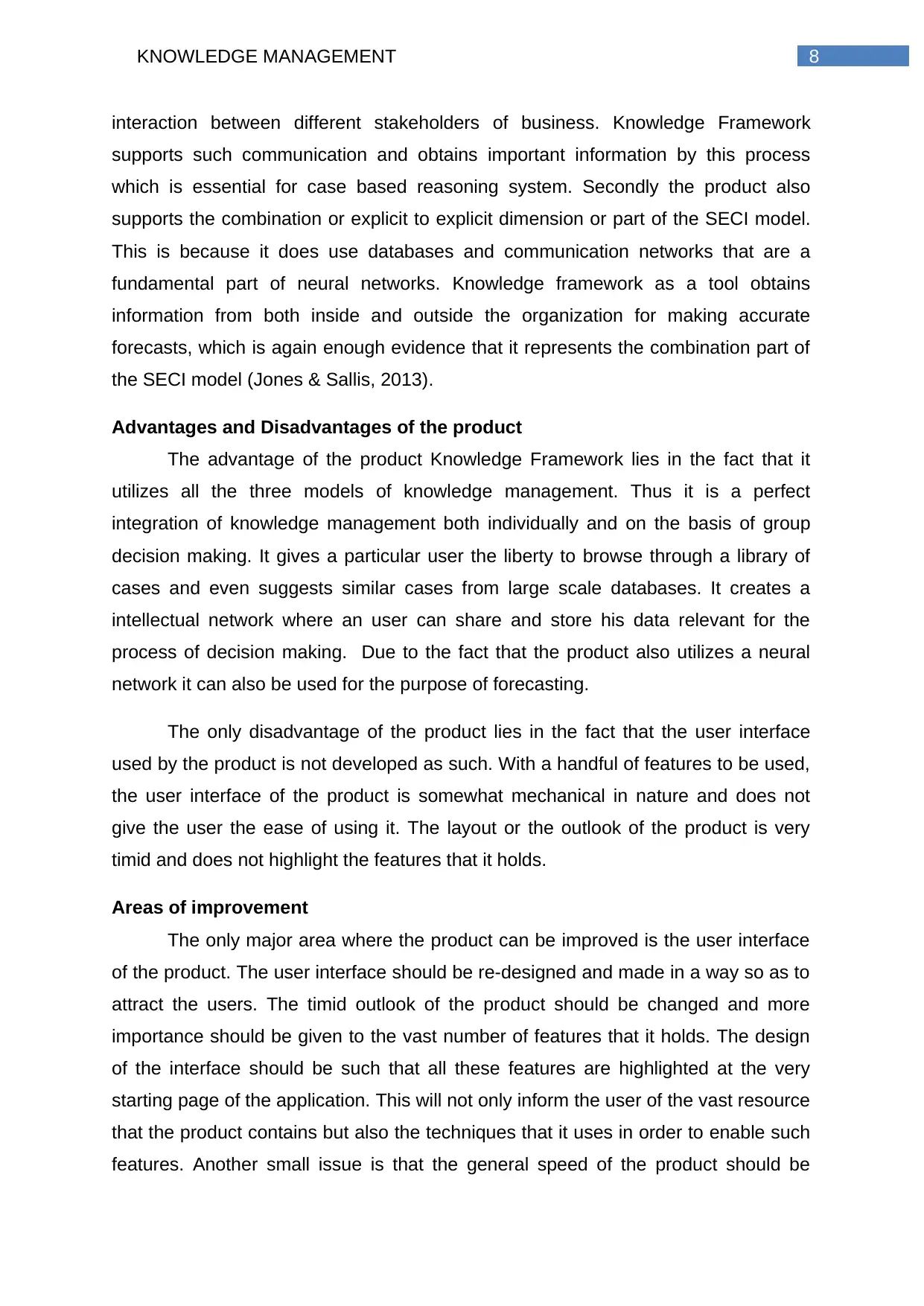
8KNOWLEDGE MANAGEMENT
interaction between different stakeholders of business. Knowledge Framework
supports such communication and obtains important information by this process
which is essential for case based reasoning system. Secondly the product also
supports the combination or explicit to explicit dimension or part of the SECI model.
This is because it does use databases and communication networks that are a
fundamental part of neural networks. Knowledge framework as a tool obtains
information from both inside and outside the organization for making accurate
forecasts, which is again enough evidence that it represents the combination part of
the SECI model (Jones & Sallis, 2013).
Advantages and Disadvantages of the product
The advantage of the product Knowledge Framework lies in the fact that it
utilizes all the three models of knowledge management. Thus it is a perfect
integration of knowledge management both individually and on the basis of group
decision making. It gives a particular user the liberty to browse through a library of
cases and even suggests similar cases from large scale databases. It creates a
intellectual network where an user can share and store his data relevant for the
process of decision making. Due to the fact that the product also utilizes a neural
network it can also be used for the purpose of forecasting.
The only disadvantage of the product lies in the fact that the user interface
used by the product is not developed as such. With a handful of features to be used,
the user interface of the product is somewhat mechanical in nature and does not
give the user the ease of using it. The layout or the outlook of the product is very
timid and does not highlight the features that it holds.
Areas of improvement
The only major area where the product can be improved is the user interface
of the product. The user interface should be re-designed and made in a way so as to
attract the users. The timid outlook of the product should be changed and more
importance should be given to the vast number of features that it holds. The design
of the interface should be such that all these features are highlighted at the very
starting page of the application. This will not only inform the user of the vast resource
that the product contains but also the techniques that it uses in order to enable such
features. Another small issue is that the general speed of the product should be
interaction between different stakeholders of business. Knowledge Framework
supports such communication and obtains important information by this process
which is essential for case based reasoning system. Secondly the product also
supports the combination or explicit to explicit dimension or part of the SECI model.
This is because it does use databases and communication networks that are a
fundamental part of neural networks. Knowledge framework as a tool obtains
information from both inside and outside the organization for making accurate
forecasts, which is again enough evidence that it represents the combination part of
the SECI model (Jones & Sallis, 2013).
Advantages and Disadvantages of the product
The advantage of the product Knowledge Framework lies in the fact that it
utilizes all the three models of knowledge management. Thus it is a perfect
integration of knowledge management both individually and on the basis of group
decision making. It gives a particular user the liberty to browse through a library of
cases and even suggests similar cases from large scale databases. It creates a
intellectual network where an user can share and store his data relevant for the
process of decision making. Due to the fact that the product also utilizes a neural
network it can also be used for the purpose of forecasting.
The only disadvantage of the product lies in the fact that the user interface
used by the product is not developed as such. With a handful of features to be used,
the user interface of the product is somewhat mechanical in nature and does not
give the user the ease of using it. The layout or the outlook of the product is very
timid and does not highlight the features that it holds.
Areas of improvement
The only major area where the product can be improved is the user interface
of the product. The user interface should be re-designed and made in a way so as to
attract the users. The timid outlook of the product should be changed and more
importance should be given to the vast number of features that it holds. The design
of the interface should be such that all these features are highlighted at the very
starting page of the application. This will not only inform the user of the vast resource
that the product contains but also the techniques that it uses in order to enable such
features. Another small issue is that the general speed of the product should be
⊘ This is a preview!⊘
Do you want full access?
Subscribe today to unlock all pages.

Trusted by 1+ million students worldwide

9KNOWLEDGE MANAGEMENT
improved, that is it should be a bit fast so that the user can get his desired
information in no time.
Part B
Knowledge management audit was performed in the organization. A survey
was conducted from five employees in the organization. Their responses were
averaged and then it was related to the closest number on the scale for each survey
question. The questionnaire has been provided in the appendix. The responses as
averaged were recorded as follows.
KM Process
P1 – 2
P2 – 1
P3 – 3
Total - 6
Comments for KM Process – The organization is still not prepared for the
implementation of knowledge management as the score accounts to be really low.
Leadership in KM
L1 – 3
L2 – 2
L3 – 2
Total – 7
Comments for KM Leadership – There is not enough leadership in the organization
to motivate the staff of the organization and convince them about the implementation
of knowledge management in the organization.
KM Culture
C1 – 4
improved, that is it should be a bit fast so that the user can get his desired
information in no time.
Part B
Knowledge management audit was performed in the organization. A survey
was conducted from five employees in the organization. Their responses were
averaged and then it was related to the closest number on the scale for each survey
question. The questionnaire has been provided in the appendix. The responses as
averaged were recorded as follows.
KM Process
P1 – 2
P2 – 1
P3 – 3
Total - 6
Comments for KM Process – The organization is still not prepared for the
implementation of knowledge management as the score accounts to be really low.
Leadership in KM
L1 – 3
L2 – 2
L3 – 2
Total – 7
Comments for KM Leadership – There is not enough leadership in the organization
to motivate the staff of the organization and convince them about the implementation
of knowledge management in the organization.
KM Culture
C1 – 4
Paraphrase This Document
Need a fresh take? Get an instant paraphrase of this document with our AI Paraphraser
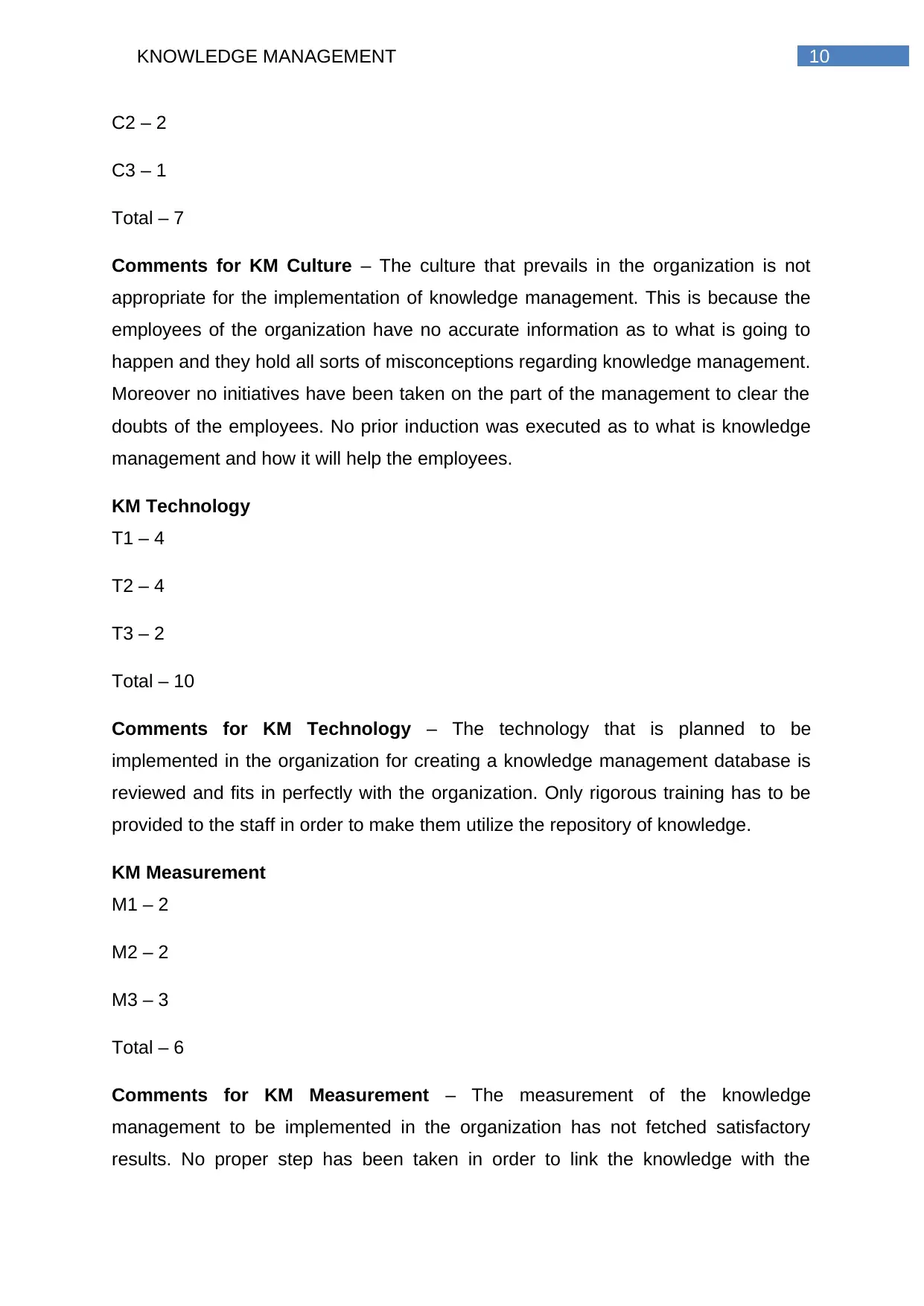
10KNOWLEDGE MANAGEMENT
C2 – 2
C3 – 1
Total – 7
Comments for KM Culture – The culture that prevails in the organization is not
appropriate for the implementation of knowledge management. This is because the
employees of the organization have no accurate information as to what is going to
happen and they hold all sorts of misconceptions regarding knowledge management.
Moreover no initiatives have been taken on the part of the management to clear the
doubts of the employees. No prior induction was executed as to what is knowledge
management and how it will help the employees.
KM Technology
T1 – 4
T2 – 4
T3 – 2
Total – 10
Comments for KM Technology – The technology that is planned to be
implemented in the organization for creating a knowledge management database is
reviewed and fits in perfectly with the organization. Only rigorous training has to be
provided to the staff in order to make them utilize the repository of knowledge.
KM Measurement
M1 – 2
M2 – 2
M3 – 3
Total – 6
Comments for KM Measurement – The measurement of the knowledge
management to be implemented in the organization has not fetched satisfactory
results. No proper step has been taken in order to link the knowledge with the
C2 – 2
C3 – 1
Total – 7
Comments for KM Culture – The culture that prevails in the organization is not
appropriate for the implementation of knowledge management. This is because the
employees of the organization have no accurate information as to what is going to
happen and they hold all sorts of misconceptions regarding knowledge management.
Moreover no initiatives have been taken on the part of the management to clear the
doubts of the employees. No prior induction was executed as to what is knowledge
management and how it will help the employees.
KM Technology
T1 – 4
T2 – 4
T3 – 2
Total – 10
Comments for KM Technology – The technology that is planned to be
implemented in the organization for creating a knowledge management database is
reviewed and fits in perfectly with the organization. Only rigorous training has to be
provided to the staff in order to make them utilize the repository of knowledge.
KM Measurement
M1 – 2
M2 – 2
M3 – 3
Total – 6
Comments for KM Measurement – The measurement of the knowledge
management to be implemented in the organization has not fetched satisfactory
results. No proper step has been taken in order to link the knowledge with the
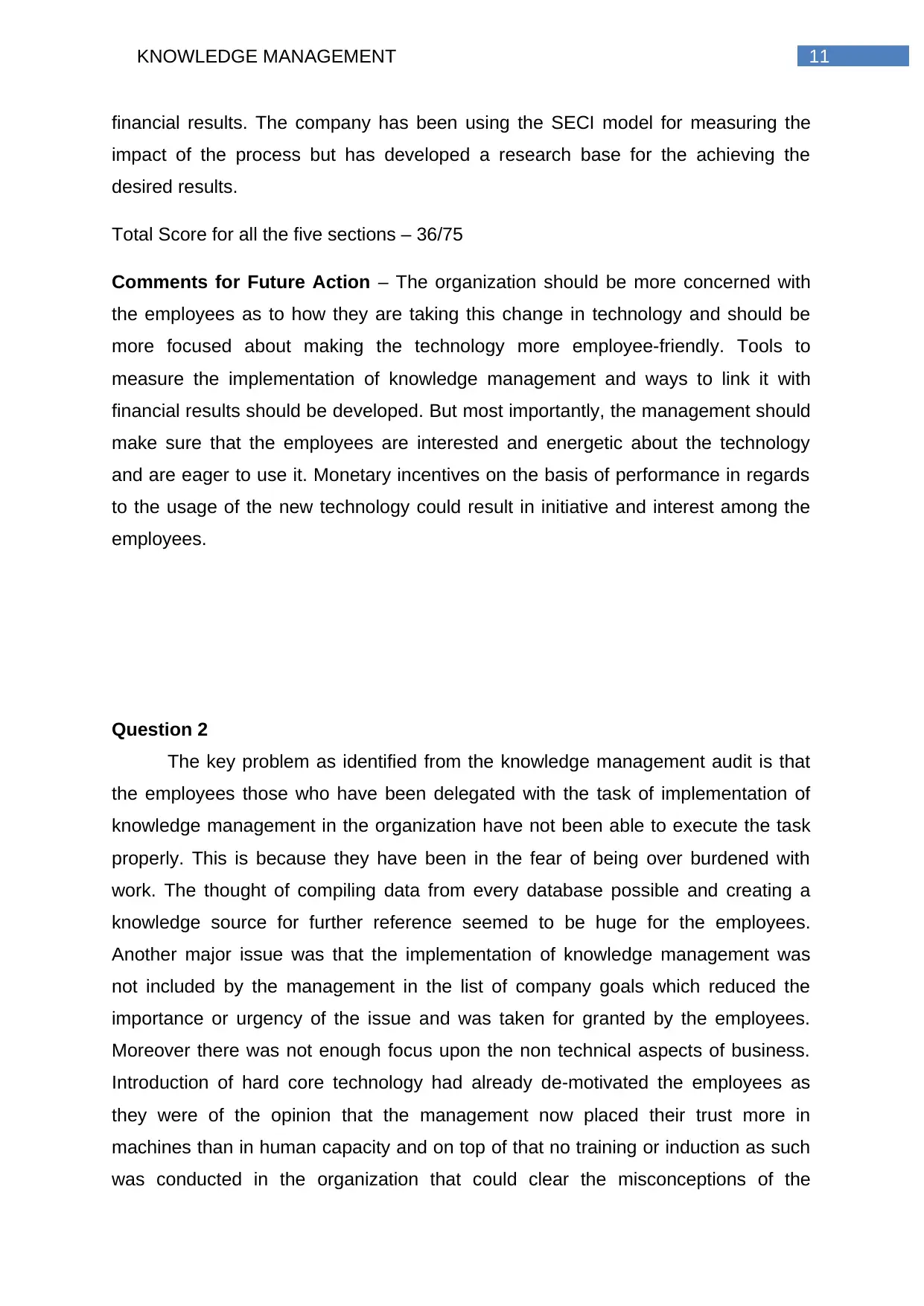
11KNOWLEDGE MANAGEMENT
financial results. The company has been using the SECI model for measuring the
impact of the process but has developed a research base for the achieving the
desired results.
Total Score for all the five sections – 36/75
Comments for Future Action – The organization should be more concerned with
the employees as to how they are taking this change in technology and should be
more focused about making the technology more employee-friendly. Tools to
measure the implementation of knowledge management and ways to link it with
financial results should be developed. But most importantly, the management should
make sure that the employees are interested and energetic about the technology
and are eager to use it. Monetary incentives on the basis of performance in regards
to the usage of the new technology could result in initiative and interest among the
employees.
Question 2
The key problem as identified from the knowledge management audit is that
the employees those who have been delegated with the task of implementation of
knowledge management in the organization have not been able to execute the task
properly. This is because they have been in the fear of being over burdened with
work. The thought of compiling data from every database possible and creating a
knowledge source for further reference seemed to be huge for the employees.
Another major issue was that the implementation of knowledge management was
not included by the management in the list of company goals which reduced the
importance or urgency of the issue and was taken for granted by the employees.
Moreover there was not enough focus upon the non technical aspects of business.
Introduction of hard core technology had already de-motivated the employees as
they were of the opinion that the management now placed their trust more in
machines than in human capacity and on top of that no training or induction as such
was conducted in the organization that could clear the misconceptions of the
financial results. The company has been using the SECI model for measuring the
impact of the process but has developed a research base for the achieving the
desired results.
Total Score for all the five sections – 36/75
Comments for Future Action – The organization should be more concerned with
the employees as to how they are taking this change in technology and should be
more focused about making the technology more employee-friendly. Tools to
measure the implementation of knowledge management and ways to link it with
financial results should be developed. But most importantly, the management should
make sure that the employees are interested and energetic about the technology
and are eager to use it. Monetary incentives on the basis of performance in regards
to the usage of the new technology could result in initiative and interest among the
employees.
Question 2
The key problem as identified from the knowledge management audit is that
the employees those who have been delegated with the task of implementation of
knowledge management in the organization have not been able to execute the task
properly. This is because they have been in the fear of being over burdened with
work. The thought of compiling data from every database possible and creating a
knowledge source for further reference seemed to be huge for the employees.
Another major issue was that the implementation of knowledge management was
not included by the management in the list of company goals which reduced the
importance or urgency of the issue and was taken for granted by the employees.
Moreover there was not enough focus upon the non technical aspects of business.
Introduction of hard core technology had already de-motivated the employees as
they were of the opinion that the management now placed their trust more in
machines than in human capacity and on top of that no training or induction as such
was conducted in the organization that could clear the misconceptions of the
⊘ This is a preview!⊘
Do you want full access?
Subscribe today to unlock all pages.

Trusted by 1+ million students worldwide
1 out of 23
Related Documents
Your All-in-One AI-Powered Toolkit for Academic Success.
+13062052269
info@desklib.com
Available 24*7 on WhatsApp / Email
![[object Object]](/_next/static/media/star-bottom.7253800d.svg)
Unlock your academic potential
Copyright © 2020–2025 A2Z Services. All Rights Reserved. Developed and managed by ZUCOL.




